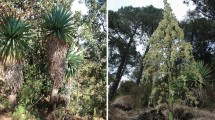Abstract
The African Acacia species A. raddiana is believed to be endangered in the Negev desert of Israel. The ecology of this species is not well understood. The main idea of our study is to learn more about the long-term population dynamics of these trees using snapshot information in the form of size frequency distributions. These distributions are highly condensed indices of population dynamics acting over many years. In this paper, we analyse field data on recruitment, growth, and mortality and use an existing simulation model of the population dynamics of A. raddiana (SAM) to produce contrasting scenarios of these live history processes that are based on the analysed field evidence. The main properties of simulated as well as observed tree size frequency distributions are characterised with Simpson's index of dominance and a new permutation index. Finally, by running the SAM model under the different scenarios, we study the effect of these different processes on simulated size frequency distributions (pattern) and we compare them to size distributions observed in the field, in order to identify the processes acting in the field. Our study confirms rare recruitment events as a major factor shaping tree size frequency distributions and shows that the paucity of recruitment has been a normal feature of A. raddiana in the Negev over many years. Irregular growth, e.g., due to episodic rainfall, showed a moderate influence on size distributions. Finally, the size frequency distributions observed in the Negev reveal the information that, in this harsh environment, mortality of adult A. raddiana is independent of tree size (age).
Similar content being viewed by others
References
Ashkenazi, S. (1995) Acacia trees in the Negev and the Arava, Israel: A review following reported large-scale mortality. Hakeren Hakayemet LeIsrael, Jerusalem (in Hebrew, with English summary).
Belsky, A. J., Amundson, R. G., Duxbury, J. M., Riha, S. J., Ali, A. R. & Mwonga, S. M. 1989. The effects of trees on their physical, chemical, and biological environment in a semi-arid savanna in Kenya. J. Appl. Ecol. 26: 1005–1024.
Belsky, A. J., Mwonga, S. M., Amundson, R. G., Duxbury, J. M. & Ali, A. R. 1993. Comparative effects of isolated trees on their undercanopy environments in high-and low-rainfall savannas. J. Appl. Ecol. 30: 143–155.
Bendel, R. B., Higgins, S. S. & Teberg, J. E. 1989. Comparison of skewness coefficient, coefficient of variation, and Gini coefficient as inequality measures within populations. Oecologia 78: 394–400.
Boulos, L. 1983. Medicinal plants of North Africa. Medicinal plants of the world. Reference Publications Inc., Algonac, Michigan, USA.
Coe, M. & Coe, C. 1987. Large herbivores, Acacia trees and bruchid beetles. S. Afr. J. Sci. 83: 624–635.
Coughenour, M. B., Ellis, J. E. & Popp, R. G. 1990. Morphometric relationships and developmental patterns of Acacia tortilis and Acacia reficiens in Southern Turkana, Kenya. Bull. Torrey Bot. Club 117: 8–17.
DeAngelis, D. L. & Huston, M. A. 1987. Effects of growth rate in models of size distribution formation in plants and animals. Ecol. Modell. 36: 119–137.
Dixon, P. M., Weiner, J., Mitchell-Olds, T. & Woodley, R. 1987. Bootstrapping the Gini coefficient of inequality. Ecology 68: 1548–1551.
Dublin, H. T. 1995 Vegetation dynamics in the Serengeti-Mara ecosystem: the role of elephants, fire, and other factors. Pp. 71–90. In: Sinclair, A. R. & Arcese, P. (eds), Serengeti II: Dynamics, management, and conservation of an ecosystem. Chicago University Press, Chicago.
Ehleringer, J. R., Cook, C. S. & Tieszen, L. L. 1985. Comparative water use and nitrogen relationships in a mistletoe and its host. Oecologia 68: 279–284.
Glasser, G. J. 1962. Variance formulas for the mean difference and coefficient of concentration. Journal of the American Statistical Association 57: 648–654.
Gourlay, I. D. 1995a. Growth ring characteristics of some African Acacia species. J. Trop. Ecol. 11: 121–140.
Gourlay, I. D. 1995b. The definition of seasonal growth zones in some African Acacia species-a review. IAWA J. 16: 353–359.
Grice, A. C. 1984. The demography of the leguminous shrubs Acacia victoriae, Cassia nemophila and C. phyllodinea in semiarid south-eastern Australia. PhD Thesis. Macquarie University, North Ryde, Australia.
Grice, A. C., Westoby, M. & Torpy, C. 1994. Dynamics and population structure of Acacia victoria Benth. Aust. J. Ecol. 19: 10–16.
Grimm, V. 1994. Mathematical models and understanding in ecology. Ecol. Modell. 75/76: 641–651.
Gwynne, M. D. 1969. The nutritive value of Acacia pods in relation to Acacia seed distribution by ungulates. E. Afr.Wildl. J. 7: 176–178.
Halevy, G. 1974. Effects of gazelles and seed beetles (Bruchidae) on germination and establishment of Acacia species. Isr. J. Bot. 23: 120–126.
Hara, T. 1984. A stochastic model and the moment dynamics of the growth and size distribution in plant populations. J. Theor. Biol. 109: 173–190.
Harper, J. L. 1977. Population biology of plants. Academic Press, New York.
Hauser, T. P. 1994. Germination, predation and dispersal of Acacia albida seeds. Oikos 71: 421–426.
Härdle, W. 1991. Smoothing techniques: With implementation in S. Springer-Verlag, New York.
Huston, M. 1986. Size bimodality in plant populations: an alternative hypothesis. Ecology 67: 265–269.
Huston, M. A. & DeAngelis, D. L. 1987 Size bimodality in monospecific populations: A critical review of potential mechanisms. Am. Nat. 129: 678–707.
Jeltsch F., Milton S. J., Dean W. R. J. & Van Rooyen N. 1997. Simulated pattern formation around artificial waterholes in the semiarid Kalahari. J. Veg. Sci. 8: 177–188.
Jeltsch F., Moloney K. A. & Milton S. J. 1999. Detecting process from snap-shot pattern-lessons from tree spacing in the southern Kalahari. Oikos 85: 451–466.
Judson, O. P. 1994. The rise of individual-based models in ecology. Trends Ecol. Evol. 9: 9–14.
Kirkpatrick, M. 1984. Demographic models based on size, not age, for organisms with indeterminate growth. Ecology 65: 1874–1884.
Kiyiapi, J. L. 1994. Structure and characteristics of Acacia tortilis woodland on the Njemps Flats. Adv. Geoecol. 27: 47–69.
Leistner, O. A. 1967. The plant ecology of the southern Kalahari. Memoirs of the Bot. Soc. S. Afr. 38: 11–73.
Levin, S. A. 1992. The problem of pattern and scale in ecology. Ecology 73: 1943–1967.
Martin, D. M. & Moss, J. M. 1997. Age determination of Acacia tortilis (Forsk.) Hayne from northern Kenya. Afr. J. Ecol. 35: 266–277.
Miller, M. F. 1996. Acacia seed predation by bruchids in an African savanna ecosystem. J. Appl. Ecol. 33: 1137–1144.
Milton, S. J. 1988. The effects of pruning on shoot production and basal increment of Acacia tortilis. S. Afr. J. Bot. 54: 109–117.
Milton, S. J. 1995. How useful is the keystone concept and can it be applied to Acacia erioloba in the Kalahari desert?. Z. Ökologie Naturschutz 4: 147–156.
Moloney, K. A., Levin, S. A., Chiariello, N. R. & Buttel, L. 1992. Pattern and scale in a serpentine grassland. Theor. Popul. Biol. 41: 257–276.
Mwalyosi, R. B. 1990. The dynamic ecology of Acacia tortilis woodland in LakeManyara National Park, Tanzania. Afr. J. Ecol. 28: 189–199.
Norton, D. A. & Carpenter, M. A. 1998. Mistletoes as parasites: host specificity and speciation. Trends. Ecol. Evol. 13: 101–105.
Obeid, M. & Seif, E. D. 1970. Ecological studies of the vegetation of the Sudan. I. Acacia Senegal (L) Willd. and its natural regeneration. J. Appl. Ecol. 7: 507–518.
Peled, Y. 1988. Mortality of Acacia trees in the southern Arava. MSc Thesis, Hebrew University, Jerusalem (in Hebrew, with English summary).
Peled, Y. 1995. Death of the Acacias. Eretz, Geogr. Mag. Israel 9: 63–65.
Pellew, R.A. 1983. The impacts of elephant, giraffe and fire upon Acacia tortilis woodlands of the Serengeti. Afr. J. Ecol. 21: 41–74.
Pielou, E. C. 1977. Mathematical Ecology. JohnWiley & Sons, New York.
Prins, H. H. & Van der Jeugd, H. P. 1993. Herbivore population crashes and woodland structure in East Africa. J. Ecol. 81: 305–314.
Ratz, A. 1996. A generic forest fire model: spatial patterns in forest fire ecosystems. PhD thesis, Philipps-Universität Marburg, Germany.
Rhoades, C. 1995. Seasonal pattern of nitrogen mineralisation and soil moisture beneath Faidherbia albida (syn Acacia albida) in central Malawi. Agroforestry Syst. 29: 133–145.
Rohner, C. & Ward D. 1999. Large mammalian herbivores and the conservation of arid Acacia stands in the Middle East. Cons. Biol., 13: 1162–1171.
Ross, J. H. 1979. A conspectus of African Acacia species. Mem. Bot. Soc. S. Afr. 44: 1–155.
Ross, J. H. 1981. An analysis of the African Acacia species: their distribution, possible origins and relationships. Bothalia 13: 389–413.
Ruess, R. W. & Halter, F. L. 1990. The impact of large herbivores on the Seronera woodlands, Serengeti National Park, Tanzania. Afr. J. Ecol. 28: 259–275.
Shackleton, C. M. 1993. Fuelwood harvesting and sustainable utilisation in a communal grazing land and protected area of the eastern Transvaal Lowveld. Biol. Cons. 63: 247–254.
Silverman, B. W. 1986. Density estimation for statistics and data analysis. Monographs on statistics and applied probability. Chapman and Hall, London, New York.
Sinclair, A. R. 1995. Equilibria in plant-herbivore interactions. Pp. 91–113 In: Sinclair, A. R. & Arcese, P. (eds), Serengeti II: Dynamics, management, and conservation of an ecosystem University of Chicago Press, Chicago, London.
Turner, M. D. & Rabinowitz, D. 1983. Factors affecting frequency distributions of plant mass: the absence of dominance and suppression in competing monocultures of Festuca paradoxa. Ecology 64: 469–475.
Van Sickle, J. 1977. Mortality rates and size distributions. Oecologia 27: 311–318.
Walker, B. H., Stone, L., Henderson, L. & Vernede, M. 1986. Size structure analysis of the dominant trees in a South African savanna. S. Afr. J. Bot. 52: 397–402.
Ward, D. & Rohner, C. 1997. Anthropogenic causes of high mortality and low recruitment in three Acacia tree species in the Negev desert, Israel. Biodivers. Cons. 6: 877–893.
Weiner, J. & Solbrig, O. T. 1984. The meaning and measurement of size hierarchies in plant populations. Oecologia (Berlin) 61: 334–336.
Weltzin, J. F. & Coughenour, M. B. 1990. Savanna tree influence on understorey vegetation and soil nutrients in northwestern Kenya. J.Veg. Sci. 1: 325–334.
Wiegand, K. 1999. A model of the spatio-temporal population dynamics of Acacia raddiana. UFZ-Bericht 15/1999, UFZ Centre for Environmental Research Leipzig-Halle GmbH, Germany.
Wiegand K., Jeltsch F. & Ward D. 1999. Analysis of the population dynamics of Acacia trees in the Negev desert, Israel with a spatially-explicit computer simulation model. Ecol. Modell. 117: 203–224.
Wiegand, K., Jeltsch, F., Ward, D. & Rohner, C. 1998. Decline of the Negev's Acacias -a spatially explicit simulation model as an aid for sustainable management. Pp. 63–72. In: J. L. Usó , J. L., Brebbia, C. A. & Power, H. (eds), Ecosystems and sustainable development, Computational Mechanics Publications, Southhampton.
Wiegand T., Milton S. J. & Wissel, C. 1995. A simulation model for a shrub ecosystem in the semiarid Karoo, South Africa. Ecology 76: 2205–2221.
Wiegand, T., Milton, S. J., Esler, K. J. & Midgley, G. 2000. Fast growth and early death: estimating size-age relations and mortality pattern of shrub species in the semiarid Karoo, South Africa. Plant Ecology, 150(1-2) in this issue.
Young, T. P. & Lindsay, W. K. 1988. Role of even-age population structure in the disappearance of Acacia xanthophloea woodlands. Afr. J. Ecol. 26: 69–72.
Author information
Authors and Affiliations
Rights and permissions
About this article
Cite this article
Wiegand, K., Ward, D., Thulke, HH. et al. From snapshot information to long-term population dynamics of Acacias by a simulation model. Plant Ecology 150, 97–114 (2000). https://doi.org/10.1023/A:1026574303048
Issue Date:
DOI: https://doi.org/10.1023/A:1026574303048




